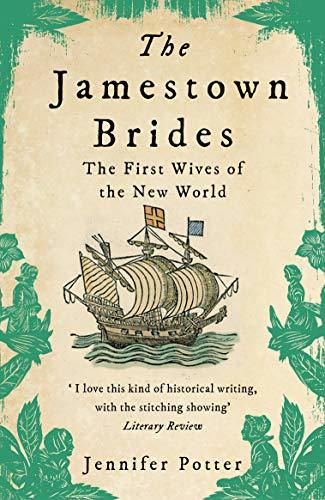The Jamestown Brides: The Untold Story of England's 'Maids for Virginia' by Jennifer Potter
Delving into company records and original sources on both sides of the Atlantic, Jennifer Potter tracks the women's footsteps from their homes in England to their new lives in Virginia. Giving voice to these forgotten women of America's early history, she triumphantly invites the reader to journey alongside the brides as they travel into a perilous and uncertain future.
Review: Jennifer Potter chases after the history of the 56 English women who traveled from London to Jamestown in 1621 to become wives of planters in the new Virginia colony. In this work of non-fiction Potter attempts to answer the question of motivations behind the journey as well as discerning what their lives might have been like and what happened to them in their new life.
Potter's book begins by detailing what was recorded about each of the women that traveled to Jamestown including their names, ages, birthplace, parents' occupations, and any known living relatives. Most were from London, and most had lost at least one parent. Potter also gives background on the Jamestown settlement and what it would have looked like and what life was likely like for the new arrivals. This included a description of their diets, homes, lifestyles, and current occupants. Life was hard and mortality was high. Men far outnumbered women, which of course explains the desire for more women to make it their home.
As many others have noted, while an absolutely fascinating topic, this book was hindered by the lack of knowledge about most of these women's fates. After four hundred years, there is just scant record of these women's lives. As a result, Potter provides a more general overview of Jamestown history itself to convey what the women's lives might have been like. In many ways it felt unsatisfactory, although this is no fault of the author, who clearly went to great lengths to scrounge up what material does exist.
Due to the way Potter leans on providing just more general history and context by talking about the Jamestown settlement itself, in many ways this just felt like another history of what can be known about the early community. In other words, it did not feel like Potter had enough source material to write a full book on the Jamestown brides and would have been better off making that a chapter in a more general book about Jamestown life.
Potter obviously worked hard to research for this book, including traveling on site to numerous locations and even talking to descendants of Jamestown residents. She uncovered what there was to share. But ultimately the huge gaps in the available knowledge left me feeling unsatisfied.
Stars: 3



Comments
Post a Comment